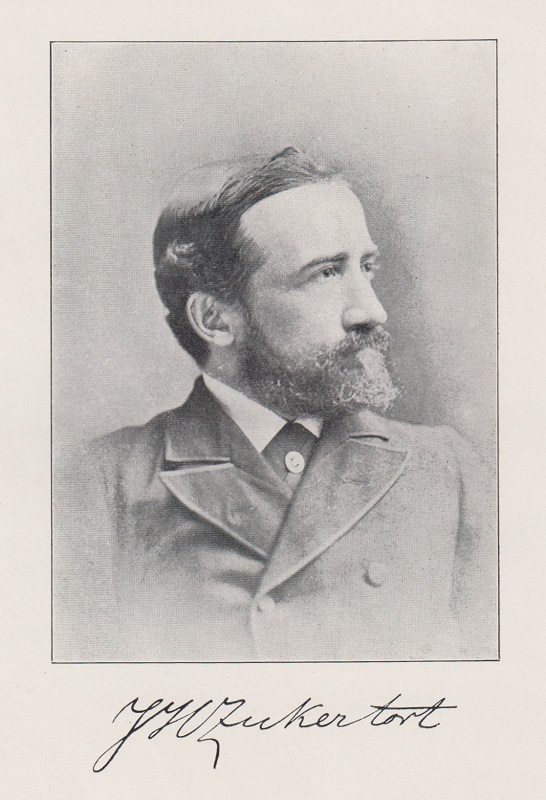
Edward Winter
(2019, with updates)

Johannes Hermann Zukertort
Frontispiece, Deutsches Wochenschach, 5 January 1913
‘He took up Sanskrit to trace the history of chess.’
That is one of innumerable claims about J.H. Zukertort presented sourcelessly by Andrew Soltis on pages 177-178 of Chess to Enjoy (New York, 1978). Chess literature offers many similar assertions; see, for instance, pages 144-145 of Wonders and Curiosities of Chess by Irving Chernev, where it was affirmed that Zukertort learned ‘Sanskrit in order to trace the origin of chess’. Chernev’s introduction to the item stated:
‘The most remarkable man that chess ever produced was Johannes Zukertort.’
The litany of boasts on Zukertort’s behalf gained widespread attention after John Keeble published an article on pages 401-403 of the October 1927 BCM:
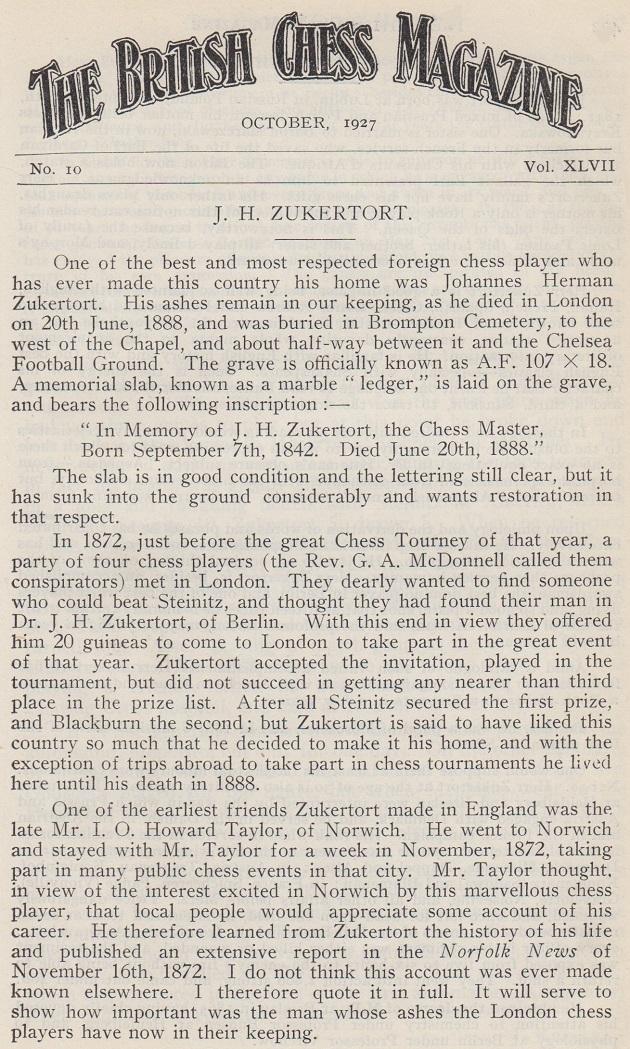
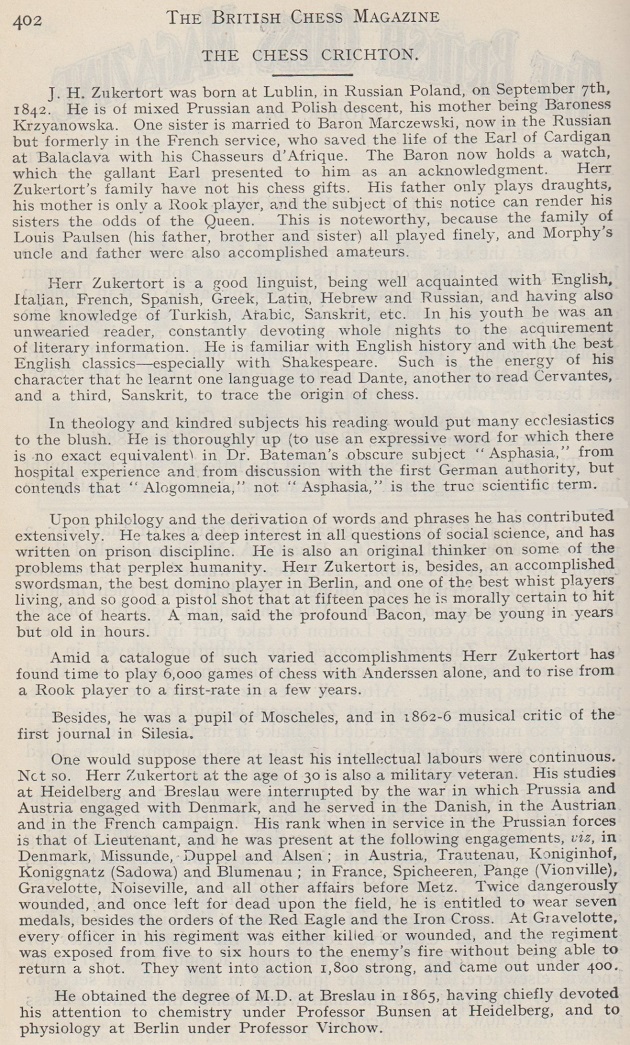
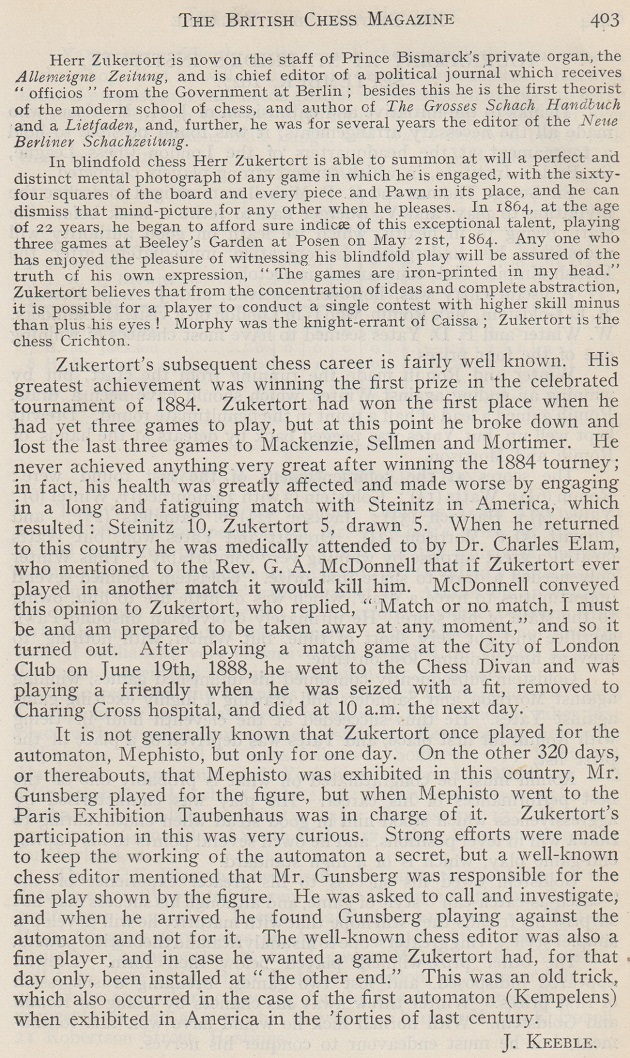
The source for the ‘Chess Crichton’ section was specified by
Keeble as being the Norfolk News of 16 November 1872, and
this was taken on trust by subsequent writers; see, for instance,
the Zukertort entry in the first edition (1984) of the Oxford
Companion to Chess, as well as Jeremy Gaige’s Chess
Personalia (1987). Especially at a time when access to old
newspapers was far more difficult than it is today, it could seem
reasonable to assume that such a citation by John Keeble (of
Norwich, Norfolk) would be reliable.
However, on page 108 of the February 1999 BCM (in K. Whyld’s Quotes and Queries column) Owen Hindle demonstrated that the reference to the Norfolk News was not right:
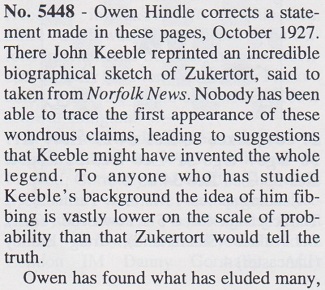

We have no information on any ‘suggestions that Keeble might have invented the whole legend’.
Below is the complete article, by I.O. Howard Taylor, published on page 4 of the Eastern Daily Press, 28 September 1872:

Whether anything similar about Zukertort ever appeared in the Norfolk News, a newspaper with which I.O. Howard Taylor was also connected, on another date (the 16 November 1872 edition published nothing) has not been ascertained.
The Keeble article was discussed in an endnote on page 375 of Eminent Victorian Chess Players by Tim Harding (Jefferson, 2012), with a reference to Owen Hindle but without mention of the contribution that he had made to the BCM in 1999:
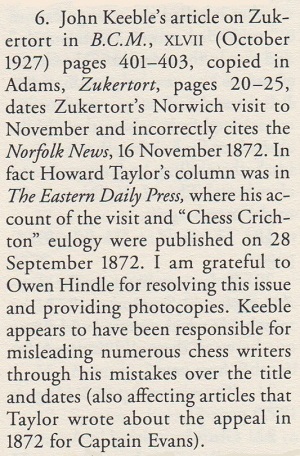
Finally for now, we show part of how Jimmy Adams’ monograph on Zukertort quoted Keeble in its two editions (1989 and 2014 – pages 20 and 21 respectively), i.e. before and after the Norfolk News reference was known to be wrong:
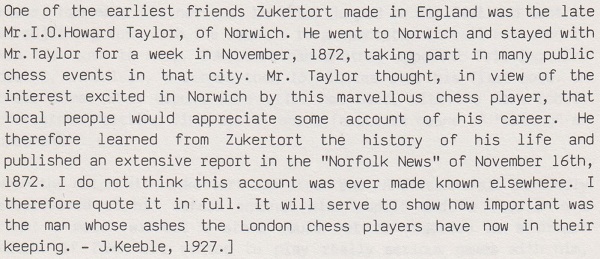
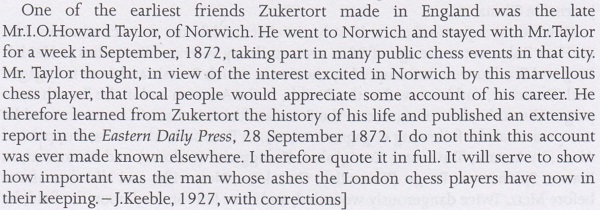
(11575)
After reproducing the ‘Chess Crichton’ article on Zukertort which was discussed in our previous C.N. item, Jimmy Adams’ book Johannes Zukertort Artist of the Chessboard (Yorklyn, 1989 and Alkmaar, 2014 – respectively on pages 23-25 and 24-25) had a section entitled ‘The Zukertort Legend’. It began:
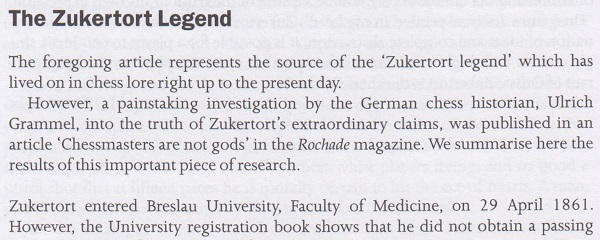
The reader may reasonably expect to be informed where exactly Ulrich Grammel published his ‘important piece of research’ on Zukertort, and it is scant help to be told, ‘in an article “Grandmasters are not gods” in the Rochade magazine’.
In connection with another book by Jimmy Adams, C.N. 10563 made an observation which could hardly seem more obvious or less controversial:
One of the many reasons why a book should give precise sources is that they enable readers to check information independently.
A note on page 225 of another monograph on Zukertort, Der Großmeister aus Lublin by Cezary W. Domański and Tomasz Lissowski (Berlin, 2005), shows the proper way of specifying where Ulrich Grammel’s research on Zukertort can be found:
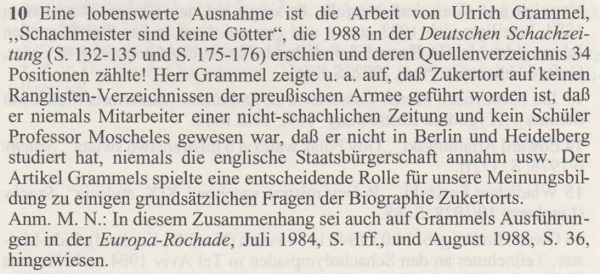
(11576)
Another writer who specified no source for Ulrich Grammel’s research apart from ‘Europe Rochade’ was Kurt Landsberger. See pages 115 and 473 of his first book on Steinitz.
A quiz question in C.N. 272:
About whom did Harry Golombek write: ‘There is about his best games a sort of resilient and shining splendour that no other player possesses.’?
The answer, in C.N. 319:
Two or three readers replied, ‘Himself’. Shame on you. The answer is Zukertort (in the Encyclopedia).
C.N. 1928 referred to the first edition of Adams’ book on Zukertort, commenting: ‘our only criticism concerns the absence of exact source references for material quoted (historical features as well as game annotations).’
C.N. 2789 (see page 227 of Chess Facts and Fables and Chess Jottings) mentioned that Zukertort’s self-promotional claims were referred to on page 19 of John Keeble’s book An English Bohemian: A Tribute to B.G. Laws (Stroud, 1933), which was part of Alain C. White’s Christmas series.
Can readers supply little-known examples of quiet moves which crown an attack? One such finish follows:
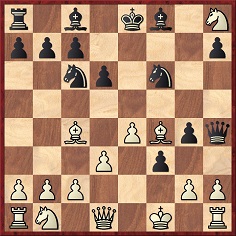
‘H’ – J.H. Zukertort (Occasion?)
Black to move.
10…fxg2+ 11 Kxg2 Qh3+ 12 Kf2 d5 13 exd5 g3+ 14 hxg3 Ng4+ 15 Kf3 Nd4+ 16 Ke4
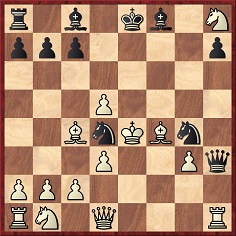
16…Bg7 and wins.
Source: the Chess Monthly, August 1881, page 375.
(2279)
A problem by Zukertort, from page 30 of his book Sammlung der auserlesensten Schach-Aufgaben (Berlin, 1869):
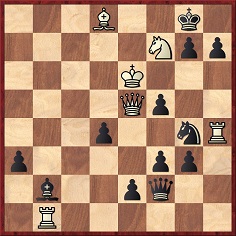
Mate in seven
The solution, which appears to be a refinement of the combination which occurred in an odds game between Deschapelles and Labourdonnais, runs as follows: 1 Rxg4 fxg4 2 Nh6+ gxh6 3 Qh8+ Kxh8 4 Kf7 d3 5 Bf6+ Bxf6 6 Rb8+ Bd8 7 Rxd8 mate.
(2349)
John Hilbert (Amherst, NY, USA) contributes this game:
Johannes Hermann Zukertort – J.S. Jones
Leadville, Colorado, 1884
French Defence
1 e4 e6 2 d4 d5 3 Nc3 Bb4 4 exd5 exd5 5 Nf3 Ne7 6 Bd3 Be6 7 O-O h6 8 Ne2 Bd6 9 Re1 Nd7 10 Nf4 Bxf4 11 Bxf4 O-O 12 Qd2 Nf5 13 c3 c6 14 Re2 Nf6 15 Rae1 Nd6
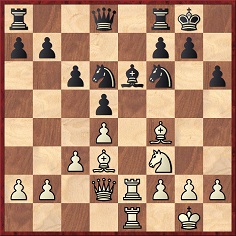
16 Bxh6 Nfe4 17 Bxe4 Nxe4 18 Qf4 gxh6 19 Rxe4 dxe4 20 Qxh6 Bf5 21 Nh4 Bh7 22 Re3 Kh8 23 Rh3 Qc7 24 Qf6+ Kg8 25 Nf5 Resigns.
Source: St Louis Globe-Democrat, 10 July 1886, with the score attributed to the Denver Times.
(2481)
Here is a curious defeat incurred by Zukertort in a simultaneous display the following year:
Johannes Hermann Zukertort – F.P. Carr
London, 21 March 1885
Vienna Gambit
1 e4 e5 2 Nc3 Nc6 3 f4 exf4 4 Nf3 g5 5 h4 g4 6 Ng5 h6 7 Nxf7 Kxf7 8 d4 d5 9 exd5 Nce7 10 Bxf4 Ng6 11 Be5 Bd6 12 Bxh8 Bg3+ 13 Kd2 Bf4+ 14 Ke1 Bg3+ 15 Kd2 Bf4+ 16 Kd3 Bf5+ 17 Kc4 b5+ 18 Kb3 Nxh8
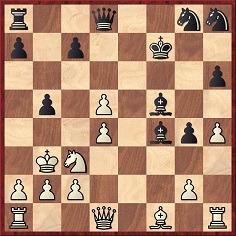
19 a3 Nf6 20 Bxb5 Rb8 21 Rf1 Nxd5 22 a4 Ne3 23 Rxf4 Nxd1 24 Rxf5+ Kg6 25 Rd5 Qg8 26 h5+ Kg7 27 Rxd1 c6 28 White resigns.
Source: BCM, May 1885, page 164.
Concerning the Jones game’s publication on page 99 of A Chess Omnibus, ‘NY’ should be deleted in the reference to the venue. A footnote on the following page of our book added, with regard to Zukertort v Carr, that a detailed description of the game and the occasion had appeared on page 141 of the April 1885 BCM.
Below are the reminiscences of the Reverend Roger John Wright of a blindfold simultaneous display (13 boards) given by Zukertort in Norfolk, England in 1872:
‘On this occasion a very amusing incident occurred, for one of our best players, anxious to perpetrate “a bit of Morphy”, solemnly announced mate in five moves. “Ah, ah!”, cried the blindfold savant as quick as thought (the very tone of his voice betraying how irrepressibly he was tickled at the idea), “is zat so? Good, very good; but I will give you ze mate in three! Paw-rn to Rook’s fo-urth, sheck!” etc., giving the would-be Morphy the coup de grâce in splendid style, and leaving him dumbfounded.
Before this blindfold performance commenced, I had the pleasure of conversing with Zukertort for some time tête-à-tête. He was frank enough to tell me that his proficiency in chess was the result of hard and prolonged study – in fact, that he had practised chess six or eight hours a day, almost continuously, for ten years! As the result of his play against us at Norwich, he won every game except one, which was drawn. It was a splendid achievement, but he was considerably overcome by the great mental strain, drops of perspiration hung on his forehead, and the veins in his head and neck stood out in a way painful to behold – sad omens of the melancholy end which ultimately befell him. He did us the honour of saying that he had never previously encountered such tough antagonists.’
Source: The Chess Bouquet by F.R. Gittins (London, 1897), pages 34-35.
The game below was played during Zukertort’s stay in Norfolk:
Capon – Johannes Hermann Zukertort
Blindfold display (12 boards), Norfolk, 1872
Giuoco Piano
1 e4 e5 2 Nf3 Nc6 3 Bc4 Bc5 4 c3 Nf6 5 d4 exd4 6 cxd4 Bb4+ 7 Bd2 Bxd2+ 8 Nbxd2 Nxe4 9 Bxf7+ Kxf7 10 Nxe4 Re8 11 Ne5+ Nxe5 12 dxe5 Rxe5 13 O-O d5 14 Nd2 Bf5 15 Re1 Rxe1+ 16 Qxe1 Qf6 17 Nf3 Re8 18 Qd1 c6 19 b3 Bg4 20 Qd4 Bxf3 21 Qxf6+ Kxf6 22 gxf3 Re2 23 a4 d4 24 Rd1 Ke5 25 b4 b6 26 a5 c5 27 axb6 axb6 28 b5 c4 29 Ra1 d3 30 White resigns.
Source: the Chess Player’s Chronicle, 1872, pages 165-166.
(2771)
Zukertort’s view, culled from page 53 of the Chess Monthly, October 1879:
‘Chess openings are, like everything else, governed by the tyrannical law of fashion. Tried friends are neglected and superseded by upstarts of doubtful origin, whose only claim to favour is that some chess swell patronized them on a more or less important occasion. All the wisdom and science of analytical writers will fail to dethrone one opening or raise another on the pedestal of public favour.’
(2233)
The sequence of items below was published on pages 325-327 of Kings, Commoners and Knaves under the heading ‘Zukertort, Zulus and Lulu’:
***
Tomasz Lissowski (Warsaw) sends an article about Zukertort by Jan Kleczyński in the Warsaw publication Tygodnik Ilustrowany of 27 February 1886. It states that Zukertort’s grandfather was English and that:
‘... for two years in Chislehurst he [Zukertort] was a teacher of a young French cesarewitch. Later as a correspondent of the Standard newspaper and as an associate of young Prince Lulu, he went to Africa, spending time among the Zulus.’
Mr Lissowski asks if any of this can be true.
A tentative start can be made by pointing out that in 1878 Zukertort was in Chislehurst for an 11-game match against Rev. John Owen. He also played the following consultation game at J.N. Strode’s residence (Camden House, Chislehurst):
Prince Louis Napoleon, Baron Corvtsart and J.N. Strode –
Johannes Hermann Zukertort (blindfold)
Chislehurst, 13 December 1878
Ponziani Opening
1 e4 e5 2 Nf3 Nc6 3 c3 d5 4 d3 f5 5 Qe2 fxe4 6 dxe4 Nf6 7 Bg5 dxe4 8 Ng1 Bf5 9 Nd2 Bc5 10 O-O-O Qd3 11 Qxd3 exd3 12 Nb3 Bxf2 13 Bxd3 e4 14 Bb5 O-O 15 Nxd4 Nd4 16 cxd4 c5 17 Bc4+ Kh8 18 d5 Bd4 19 h3 b5 20 Be2 Nxd5 21 g4 Bg6 22 a3 a5 23 Bxb5 Rab8 24 a4 Nb4 25 Ne2 e3 26 Nxd4 Na2 mate.
Source: Deutsche Schachzeitung, February 1879, pages 42-43.
Page 1067 of the Chambers Biographical Dictionary (Edinburgh, 1990) says that in March 1871 Napoleon III ‘joined the ex-empress at Chislehurst, Kent, and resided there in exile until his death [in 1873]. His son, Eugene Louis Jean Joseph (1856-79), Prince Imperial, was in the field with his father in 1870, but escaped to England, where he entered Woolwich Academy. He was killed in the Zulu campaign of 1879.’
(Kingpin, 1995)
No new information has yet emerged regarding the Zukertort item, but a connection may be noted here between the Napoleon clan, J.N. Strode’s residence in Chislehurst and another chess personality, James Mortimer. His obituary on pages 100-101 of the May 1911 American Chess Bulletin had the following tailpiece:
‘In the course of his sojourn in Paris Mr Mortimer became an intimate of Napoleon III, and was the last person who spoke to him before the fatal operation at Chislehurst in 1873, where Mr Mortimer had procured shelter for the exiled imperial family at the house of his friend Strode.’
(Kingpin, 1996)
The above items were given on pages 325-326 of Kings, Commoners and Knaves with this conclusion:
Pages 350-351 of the August 1909 BCM quoted from an article by Hoffer in The Field of 10 July 1909:
‘The late Mr Strode, owner of Chiselhurst [sic] – the residence of the late Emperor Napoleon – was a great admirer of Kolisch, and a keen sportsman. Feeling that young Kolisch – who was more interested in the attractions of London than in the match [against Louis Paulsen] – would lose it, he made the proposal at the eleventh hour that he would give Kolisch £5 for every game he did not lose, provided he accepted his hospitality at Chislehurst. Kolisch consented, came up to town with his host, and returned with him to Chistlehurst after the conclusion of each game, and this is the reason that 18 draws occurred.’
An extract from The Facts about Larry Evans:
In his December 1999 column, an item about the age factor in chess masters, Evans was asked a question which included a reference to a match (against Steinitz) which Zukertort was said to have played, at the age of 44, in 1892. As we pointed out in the February 2000 issue (page 8), this was unlikely, given that Zukertort had died in 1888. That could have been the end of the matter, but Evans’ response on the same page was as emphatic as it was false:
‘Edward Winter has an exaggerated notion of his own importance and, as usual, makes mountains out of molehills (obviously 1892 was a typo instead of 1872).’
He continued to construct his own mountain in the July 2001 column:
‘Does Mr Winter truly believe it [i.e. the date 1892] was anything more than a typographical error? I think not.’
An interesting question. The date 1892 that appeared in the December 1999 issue was obviously wrong, but was it, as Evans assured his readers, an obvious typo for 1872? Definitely not, for the simple reason that 1872 is also wrong. Since the Steinitz-Zukertort match under discussion was specified as having been played when Steinitz was 50 and Zukertort was 44 (although their actual ages were 49 and 43 respectively), the event was ‘obviously’ their world championship match of 1886. A normal writer would be embarrassed to discover that in endeavouring to correct one wrong date (1892) he had categorically and disparagingly put forward another one (1872) which in reality was even further from the right one (1886).
F.J. Marshall writing about 1 Nf3 on page 16 of his 1932 book Comparative Chess:
‘The Zukertort opening named after a former champion of the world.’
(Kingpin, 1999)
From page 65 of part one of Garry Kasparov on My Great Predecessors (London, 2003), concerning the 1886 world championship match (ten games up) between Steinitz and Zukertort:
‘There was an important nuance: with a score of 9-9 the match would be considered to have ended in a draw, since the players did not want the outcome of such an important duel to rest on the result of one game. Such a rule was to apply later in a number of unlimited matches for the world championship, and it became a stumbling-block in the years when Fischer was champion (as will be described in a later volume).’
It is indeed true that Steinitz and Zukertort’s contract (29 December 1885) stipulated:
‘The Score at Nine Games. Should the score stand at nine (9) games won to each of the players, then the match shall be declared drawn.’
Source: the Chess Monthly, January 1886, pages 136-137.
However, on page 118 of the May 1886 International Chess Magazine Steinitz reported that this provision had been amended before the final series of games began in New Orleans on 26 February 1886:
‘Two of the conditions of the match [one of them omitted here, being a minor matter concerning playing hours] were altered by mutual consent of the players, who had agreed, in the first place, to reduce the score, which rendered the match a draw, to eight all, instead of nine all, as previously stipulated. There can be no doubt that both the principals acted bona fide and chiefly in the interest of their backers in agreeing to such a modification of the original terms of the match, for their main reason in adopting the alteration was to exclude all element of chance as much as possible and to avoid rispgg the issues at stake on the result of two games. But, on consideration and in order not to establish a questionable precedent, we feel bound to say that the opinions of some critics, who, without in the least impugning the motives of the two principals, have expressed doubts on the legality of such proceeding, now appear to us reasonable. For it is justly contended that the two players had no right to alter any of the main conditions of the match without consulting their backers, who had deposited their stakes after the chief terms had apparently been finally settled …’
(3324)
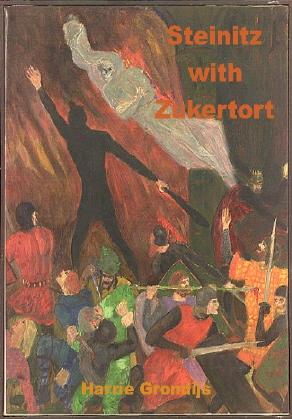
From Harrie Grondijs (Rijswijk, the Netherlands):
‘For my book Steinitz with Zukertort (Rijswijk, 2006) I tried to retrace Zukertort’s travels and games in the United States in 1883-84. As shown on pages 97 and 239, next to nothing is known about his chess activities in Washington. I have, however, now found on page 188 of the Irish Sportsman, 22 March 1884 a game which he played in a three-board blindfold display at the Washington Chess Club.’
Johannes Hermann Zukertort (blindfold) – Jacob Frech
Washington, 21 December 1883
Evans’ Gambit Accepted
1 e4 e5 2 Nf3 Nc6 3 Bc4 Bc5 4 b4 Bxb4 5 c3 Be7 6 d4 d6 7 Qb3 Be6 8 Bxe6 fxe6 9 Qxe6 Qd7 10 Qb3 b6 11 O-O Na5 12 Qc2 Bf6 13 Rd1 Nc6 14 Na3 Nge7 15 Nc4 Ng6 16 dxe5 Ngxe5 17 Nfxe5 Nxe5 18 Nxe5 Bxe5 19 f4 Bf6 20 e5 Be7 21 Qb3 O-O-O
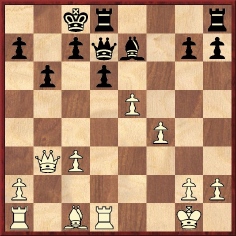
22 a4 Qc6 23 Ba3 Rhe8 24 a5 dxe5 25 Bxe7 Rxd1+ 26 Rxd1 Rxe7 27 fxe5 Qc5+ 28 Kh1 Qxe5 29 h3 Qxa5 30 Qg8+ Kb7 31 Qxh7 Qxc3 32 Qf5 Re1+ 33 Rxe1 Qxe1+ 34 Kh2 Qe7 35 Qc2 a5 36 Qc4 c6 37 h4 b5 38 Qd4 a4 39 Kh3 a3 40 g4 a2 41 h5 Qa3+ 42 White resigns.
(4720)
C.N. 4726 asked who was the last surviving master who had come into personal contact (not necessarily over the board) with J.H. Zukertort (1842-88). The person we had up our sleeve was Sir George Thomas (1881-1972), but we note now that the wording of Assiac’s account on pages 47-48 of The Delights of Chess (London, 1960) indicates that ‘personal contact’ did not occur:
‘Having met so many of his contemporary masters – contemporary through several generations and ranging from Steinitz and Chigorin through Lasker, Pillsbury, Tarrasch to Keres and Reshevsky, Penrose and Petrosian – Sir George has some fascinating stories to tell about many of them. Indeed, Zukertort would seem to be about the only one of the “old-timers” he never met to speak to, though he saw even him at a (respectful) distance while admitted to his mother’s drawing-room as a child of six or seven.’
(4764)
Page 22 of the booklet Schach WM 2008 Deutschland has a photograph of Zukertort and Steinitz which was new to us, and we are grateful to Michael Negele (Wuppertal, Germany) for the opportunity to present it here:
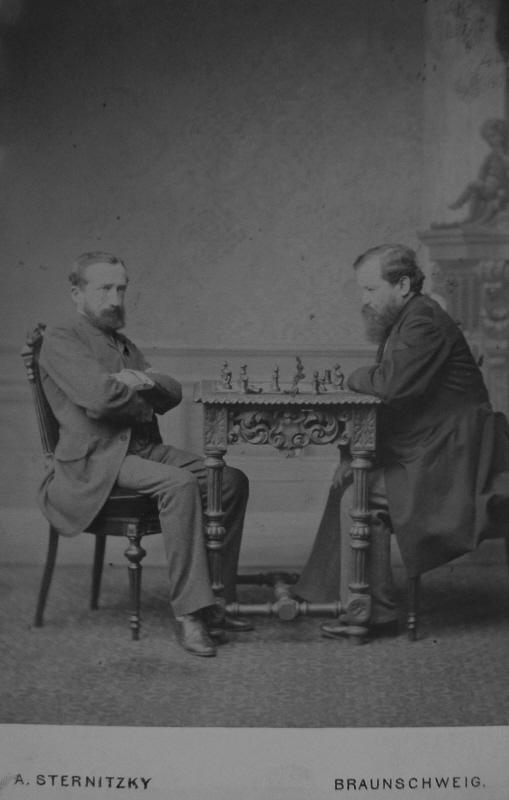
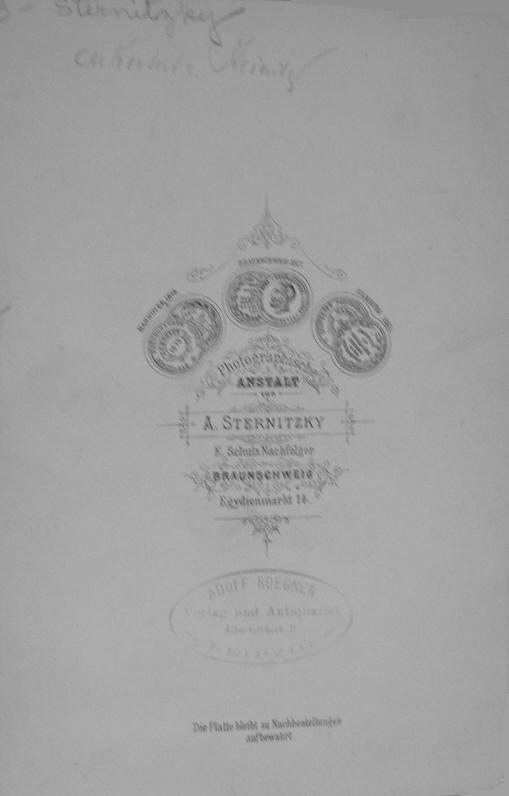
Mr Negele found the photograph in the archives of the Cleveland Public Library in 2007. Although the booklet states that it was taken in 1886, our correspondent suggests that the occasion was Brunswick, 1880, a tournament which, as stated on page 235 of the August 1880 Deutsche Schachzeitung, both Zukertort and Steinitz visited.
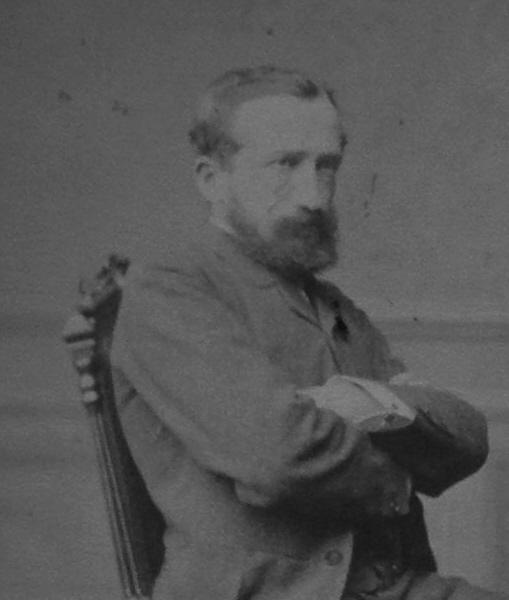
J.H. Zukertort
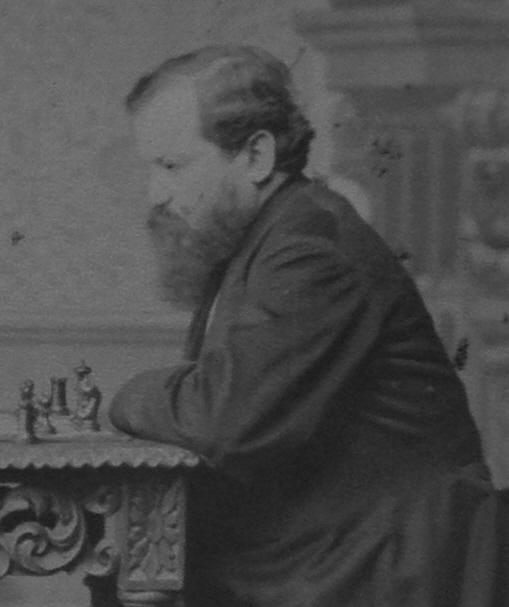
W. Steinitz
(7795)
See too C.N. 9864 (an interview with Zukertort on page 8 of the St Louis Daily Globe-Democrat, 29 December 1883).
As noted in Historical Havoc (an article we published in 1998), page 13 of World Champion Openings by Eric Schiller (New York, 1997) referred to ‘Emil Zukertort’. Any respectable writer would, of course, take the earliest possible opportunity to correct the blunder. Consequently:

World Champion Openings by E. Schiller (first edition – New York, 1997)
World Champion Openings by E. Schiller (second edition – New York, 2002)

World Champion Openings by E. Schiller (third edition – Las Vegas, 2009).
A few lines later, in all three editions, mention is made of another world championship challenger, Isidore [sic] Gunsburg [sic].
(6383)
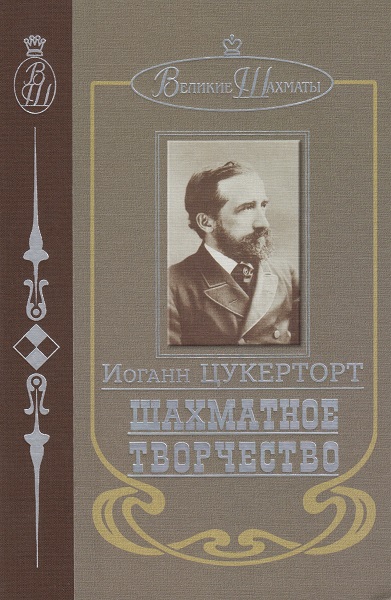
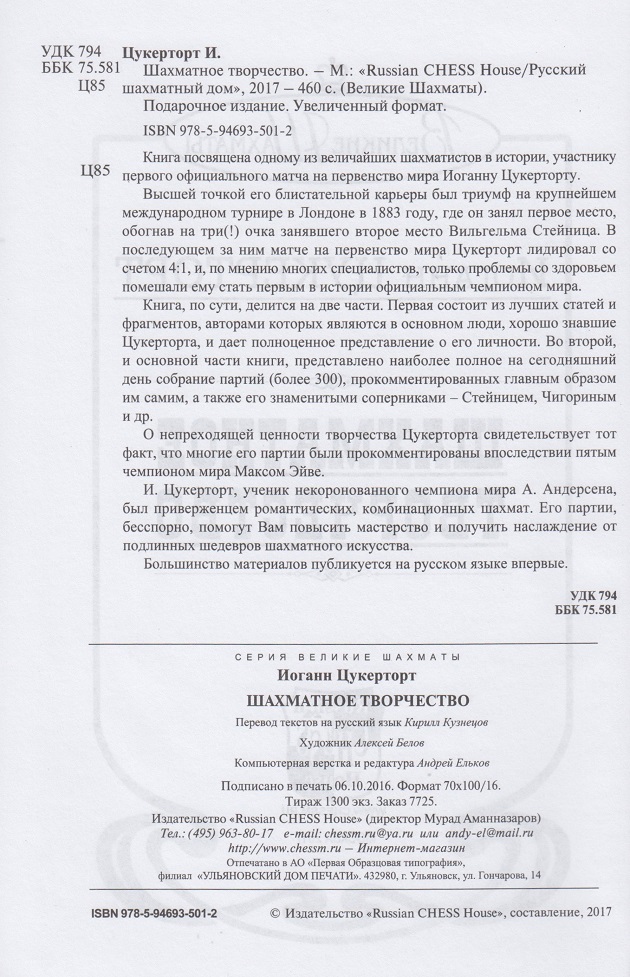
How soon, if at all, will readers of this 458-page hardback realize that it is a translation of Jimmy Adams’ work on Zukertort (Yorklyn, 1989 and Alkmaar, 2014)?
(10553)
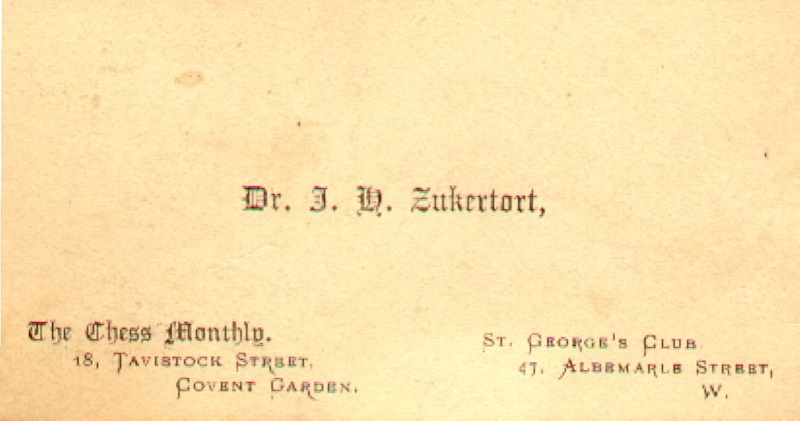
See also The 23 Ng5 Affair (Skipworth v Zukertort) and The Chess Masters of To-day by Leopold Hoffer.
.To the Chess Notes main page.
To the Archives for other feature articles.
Copyright: Edward Winter. All rights reserved.